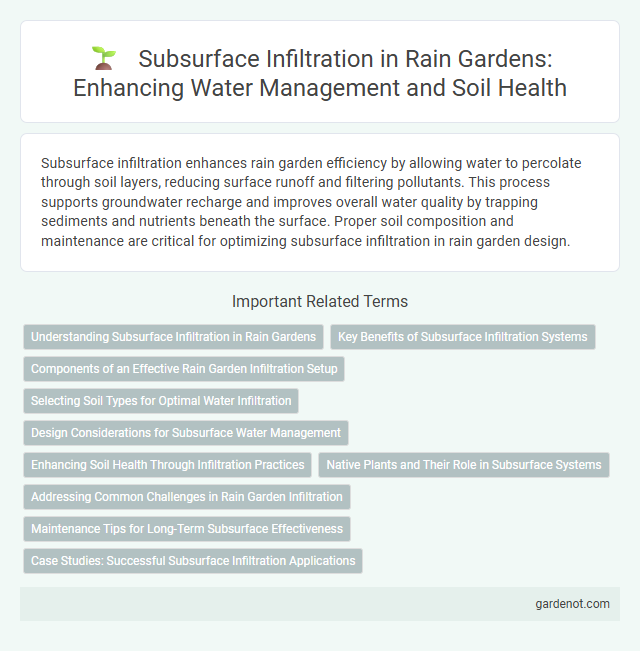Subsurface infiltration enhances rain garden efficiency by allowing water to percolate through soil layers, reducing surface runoff and filtering pollutants. This process supports groundwater recharge and improves overall water quality by trapping sediments and nutrients beneath the surface. Proper soil composition and maintenance are critical for optimizing subsurface infiltration in rain garden design.
Understanding Subsurface Infiltration in Rain Gardens
Subsurface infiltration in rain gardens involves the process where stormwater percolates through engineered soil layers beneath the surface, enhancing groundwater recharge and reducing surface runoff. Proper design includes selecting permeable soil media and incorporating gravel or sand layers to optimize water retention and filtration. This approach mitigates flooding, improves water quality by removing contaminants, and supports sustainable urban drainage systems.
Key Benefits of Subsurface Infiltration Systems
Subsurface infiltration systems enhance stormwater management by efficiently capturing and filtering runoff beneath the soil surface, reducing surface flooding and erosion. These systems improve groundwater recharge by allowing water to naturally percolate through soil layers, promoting aquifer replenishment. They also prevent pollutants from entering waterways by trapping sediments and nutrients, supporting healthier ecosystems and water quality.
Components of an Effective Rain Garden Infiltration Setup
An effective rain garden infiltration setup relies on a well-designed subsurface layer composed of porous soils, coarse sand, and gravel to maximize water permeability. Incorporating an underdrain system with perforated pipes ensures efficient drainage and prevents waterlogging while protecting surrounding structures. Properly layered media enhances pollutant filtration and supports healthy plant growth, optimizing stormwater management and groundwater recharge.
Selecting Soil Types for Optimal Water Infiltration
Selecting soil types with high permeability, such as sandy loam or loamy sand, enhances subsurface infiltration in rain gardens by promoting efficient water absorption and reducing surface runoff. Soils with moderate to high infiltration rates, typically ranging from 0.5 to 2.0 inches per hour, optimize rain garden performance by facilitating rapid water percolation while supporting plant health. Incorporating amendments like compost can improve soil structure and infiltration capacity, ensuring long-term effectiveness of the rain garden's subsurface water management.
Design Considerations for Subsurface Water Management
Effective design considerations for subsurface infiltration in rain gardens prioritize soil permeability, ensuring adequate porosity to facilitate water absorption and prevent surface runoff. Incorporating layers of engineered media such as gravel and sand enhances water distribution and retention within the root zone, optimizing filtration and groundwater recharge. Properly sizing the infiltration basin based on local rainfall intensity and soil infiltration rates is critical to prevent system overload and maintain long-term functionality.
Enhancing Soil Health Through Infiltration Practices
Subsurface infiltration in rain gardens promotes enhanced soil aeration and microbial activity by facilitating the percolation of water through organic-rich soil layers. This process improves nutrient cycling and reduces surface runoff, aiding in the replenishment of groundwater while supporting plant root health. Effective infiltration practices restore soil structure, increase moisture retention, and encourage beneficial soil organisms essential for sustainable ecosystem function.
Native Plants and Their Role in Subsurface Systems
Native plants play a crucial role in subsurface infiltration systems by enhancing soil permeability and promoting water absorption. Their deep root networks create channels that facilitate the movement of stormwater into underlying soils, supporting groundwater recharge. Selecting native species adapted to local climate and soil conditions ensures optimal performance and long-term sustainability of rain gardens.
Addressing Common Challenges in Rain Garden Infiltration
Subsurface infiltration in rain gardens effectively manages stormwater by allowing runoff to seep into the soil, reducing surface water and preventing flooding. Key challenges such as soil compaction, high water tables, and poor infiltration rates require careful soil amendment and site assessment to ensure optimal permeability. Implementing engineered soil mixes and incorporating underdrains can enhance infiltration performance and maintain rain garden functionality during heavy rainfall events.
Maintenance Tips for Long-Term Subsurface Effectiveness
Regular inspection and removal of debris from the subsurface infiltration layers ensure unobstructed water flow and prevent clogging in rain gardens. Periodic soil aeration and maintaining healthy vegetation promote permeability and enhance water absorption capacity. Monitoring for sediment buildup and promptly addressing erosion can sustain the long-term effectiveness of the infiltration system.
Case Studies: Successful Subsurface Infiltration Applications
Case studies of successful subsurface infiltration in rain gardens demonstrate significant improvements in stormwater management by reducing surface runoff and enhancing groundwater recharge. Projects implementing engineered gravel layers and perforated pipe networks consistently achieve infiltration rates exceeding 80%, effectively mitigating urban flooding and pollutant loads. Notable examples include municipal parks and residential developments where subsurface infiltration systems sustainably manage average rainfall volumes of 1 to 2 inches per event.
Subsurface infiltration Infographic

 gardenot.com
gardenot.com